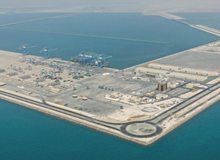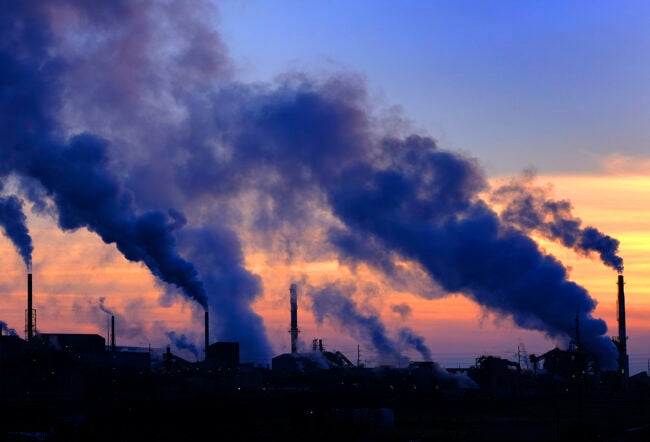From Duqm in Oman to Boubyan island in Kuwait, Arab Gulf states are tapping oil revenues to expand and construct ports alongside mammoth industrial zones. Regionally, over US$35 billion is being spent on various port projects to drive trade, job and non-oil economic growth.
The need to economically diversify has spurred the strategy to become a hub for global logistics and non-oil exports, as geography puts the region between the trade flows of the West and the ever-burgeoning economies of the East. But the countries risk vying for the same cargo traffic, and ending up with overcapacity against a backdrop of slow global trade flow and anemic Western economies.
Gulf countries are counting on the increased trade links between them and Asia and their growing attraction as a gateway to Africa. Some Gulf ports are seeking a trans-shipment role to serve underserved markets of Iraq, Iran, Pakistan and other neighboring countries that do not have the economic or political ability to attract ships.
Last year, the wealthy emirate of Abu Dhabi lauched the mega port trend, by inaugurating the US$7.2 billion Khalifa Port, with an initial capacity of 2.5 million twenty-foot equivalent units (TEU), backed up by the Khalifa Industrial Zone Abu Dhabi (KIZAD), all built on a man-made island on the edges of the UAE capital two thirds the size of Singapore. The modern port replaces Mina Zayed, a 40-year old facility located inside the capital that was getting close to its 1 million TEU capacity.
“Forty years ago it was fantastic to have a downtown location," said Morten Lund, Commercial Manager of Khalifa Port Container Terminal. "Now ships are getting bigger, they are getting wider and they are getting deeper and they have a lot more cargo on board, which meant in the last many years it was impossible for the shipping lines to serve the Abu Dhabi market directly."
Bigger Ambitions
But Khalifa Port has bigger ambitions than just replacing an old facility. The port and industrial zone are forecast to create over 100,000 jobs and contribute 15% of Abu Dhabi’s non-oil GDP by 2030, when capacity is set to reach 15 million TEU. Dubai’s Jebel Ali port, the world’s No. 9 container port that lies just 45 km from Khalifa Port, now has a 14 million TEU capacity that will reach 15 million TEU this year and increase to 19 million TEU by 2014.
“There is the existing Abu Dhabi business that we need to cater for in a way that allows Abu Dhabi businesses to grow and prosper,’ said Lund.
Khalifa Port is seeking to serve the rising exports from Abu Dhabi firms like Emal, which is building the world’s biggest aluminum smelter and petrochemical producer, Borouge, and also attract trans-shipment business, which is currently catered by Dubai’s Jebel Ali port and to a lesser extent Khor Fakkan port. Khalifa Port is currently doing trans-shipment business for the Indian subcontinent for Italy’s Messina Line, its first trans-shipment customer, said Lund.
“There will be some diminishing market share (for Dubai), but I am not seeing it as losing it in a big way or losing its leading position, as a whole,’ said Shailesh Garg, a director at shipping consultant Drewry in India. “Jebel Ali was ahead of its times in terms of infrastructure and these ports entered the market a bit late or they didn’t have enough traffic to justify those developments. Jebel Ali had taken that early mover advantage and the biggest advantage is its free trade zone that keeps generating traffic in a big way. That’s why you see a country like Oman, which has its own ports, still getting transit traffic from Jebel Ali.’
Jebel Ali has attracted most shipping business because it is a big market for Emirates-bound cargo and trans-shipment business to neighboring cities and countries. Khor Fakkan is mainly a small trans-shipment hub that benefits from its location outside the Strait of Hormuz, close to the East-West shipping route.
Khalifa Port, though, does not have Jebel Ali’s strategic mix of vast local cargo and trans-shipment business nor an attractive location such as Khor Fakkan.
“There is a lot of growth in the export side for Abu Dhabi, when you look at Emal and you look at Borouge, volumes they will see this year and next year means the old port in Abu Dhabi could not handle it. So from an Abu Dhabi local perspective, it is very good,’ said Lars Nielsen, managing director for the UAE, Qatar, Oman, and Iran for Maersk Line. “On a regional level, at least in the foreseeable future, Abu Dhabi will remain a local port, so it is not going to be a direct competitor, for instance to Jebel Ali’s trans-shipment aspect of the business.’
Jebel Ali, the biggest trans-shipment port in the region, is not sitting idle though. It is focusing on upgrading its port to cater to bigger ships, which are calling more often at its facilities as shipping lines rely on economies of scale to deliver cargo to save on cost. Jebel Ali is expanding even though volumes have faltered. DP World, the world’s third largest port operator that manages Jebel Ali, handled 13.3 million TEU in 2012 in the UAE, almost unchanged from the 13 million TEU in 2011. Jebel Ali accounts for most of the container traffic for DP World in the UAE.
“I don’t think there is a competition. There is a growth coming into this region and in the last 10 years there wasn’t much development taking place in the port industry,’ said Mohammed Al Muallem, senior vice-president and managing director, DP World UAE region. “We are not purely trans-shipment, we are gateway and we have lots of cargo which belongs to the UAE. We are 50-50% and we are quite balanced, so we will continue to develop our facilities to meet future demand.’
Growing Competition
Transshipment rates tend to be much lower than gateway traffic rates, driving competition among ports trying to attract shipping firms.
Meanwhile, Qatar, with a population of 1.7 million, is investing $7.4 billion on a new port, zone and other facilities in Doha to help lift the strain on its old harbor, which cannot serve the economic needs of the world’s No. 1 liquefied natural gas exporter and its vast infrastructure projects, especially for hosting football’s World Cup in 2020.
Although the new Doha port will have an initial capacity of 2 million TEU when it opens in 2016, it is planned to reach 6 million TEU by 2030.
Saudi Arabia, the world’s biggest oil exporter, is upgrading a number of ports from Jeddah on the Red Sea to Dammam in the Persian Gulf, which are facing congestion due to the kingdom’s rising petrochemical and industrial exports, as well as imports.
Oman is increasing capacity at two ports, in the industrial zone cities of Sohar and Salalah, which is becoming a trans-shipment hub that benefits from its location outside the Strait of Hormuz. Salalah port, which currently has a capacity of 6 million TEU, could lift capacity to 9 million TEU in the coming years, depending on increase in demand.
Oman is also building an industrial city in Duqm that includes a port focusing on transit-trade, which could be an alternative way to transfer cargo by land or rail to neighboring countries, especially if ships call on the port, which lies outside the Strait of Hormuz and skirts regional tensions that have threatened its closure.
“Having a port outside the Strait in the eventuality the port is closed is obviously a benefit, but the potential threat of the Strait closing down, is not big enough to drive you away from the most efficient port, which today is inside the Strait,’ said Maersk’s Nielsen.
The region, though, already has teething port issues.
Bahrain’s Khalifa Bin Salman Port, with a current capacity of 1.1 million TEU, handled around 332,000 TEU in 2011. The port, run by Denmark’s A.P. Moller-Maersk A/S, caters to a local population of around 1.3 million and has tried to market itself as a trans-shipment hub for the upper Gulf, to serve nearby Qatar, Kuwait, and parts of Saudi Arabia, Iran and Iraq.
Not very far from Bahrain, two countries with a bloody history have sparred over port developments. Kuwait’s plan to build the Mubarak Al-Kabeer port on Boubyan island a few kilometers away from Iraq’s Grand Faw Terminal development created tension in 2011, which both countries have tried to smooth.
“The main threat is that of failing to carve out a niche in an increasingly crowded marketplace and ending up as just another white elephant,’ said Jamie Ingram, Middle East Analyst at IHS Global Insight. “A global economic downturn would be a significant threat to the ports if it led to a drop in oil price and led their markets to dry up.’



